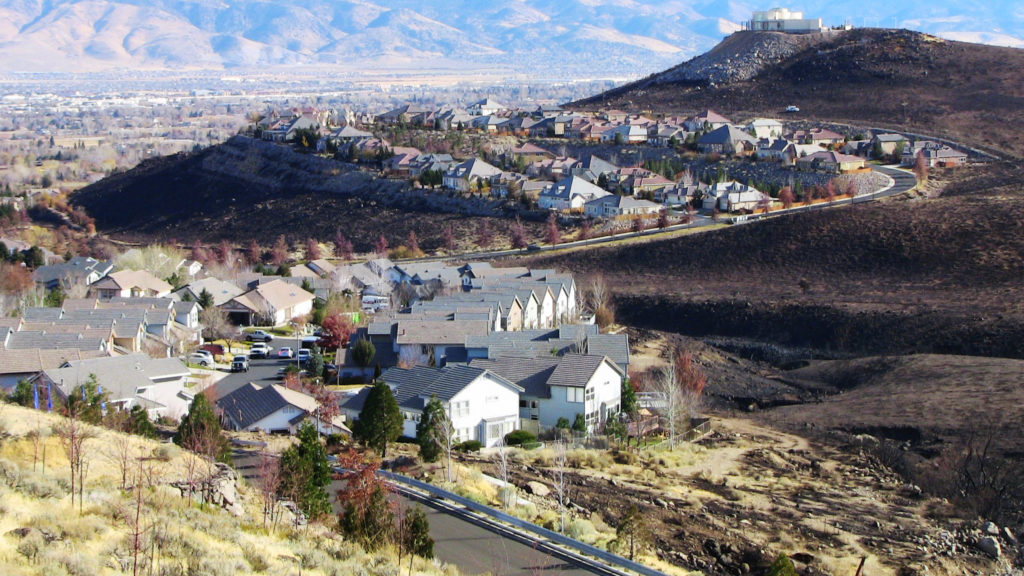Five Lessons Learned Following the Caughlin Fire
November 17th, 2017
After the Caughlin Fire. Photograph Courtesy of University of Nevada Cooperative Extension
I awoke to the smell of thick campfire-like smoke that had filtered into my bedroom. I jumped out of bed, turned on the bedroom light switch and nothing… the electricity was out. I ran to the window to see the glow of flames cresting the hill on the other side of McCarran Blvd., a major four-lane Reno street. Since the wind was blowing and the fire was close and spreading, I made the decision to evacuate. Outside, the sky was orange from the wildfire and the street was congested with fire engines and vehicles of evacuating residents. Fortunately, I was able to negotiate the chaos safely with my laptop in one hand and some clothes in the other. I’m lucky that my residence and I were unscathed from the wildfire. In the early morning hours of November 18, 2011, this was my experience during the Caughlin Fire. This Saturday marks the six-year anniversary of this fire. A total of 1900 acres and 43 structures were destroyed or damaged and 8,000 people were evacuated. Continue reading and consider these lessons learned from the Caughlin Fire.
Be aware that wildfires can occur in the autumn and winter:
The Caughlin Fire occurred during the middle of November. The winds, coupled with dry vegetation and windblown tree branches that struck a powerline were the culprits for this wildfire. Winds blew at 20-30 mph gusting to 60 mph and the area had experienced an “abnormal dryness pattern”. The fire started when windblown tree branches struck a powerline, generated sparks and ignited the dry vegetation above the Caughlin Ranch area. The winds then carried the fire and embers to burn a total of 1900 acres. This situation shows that wildfires can start and spread year round.
Prepare for evacuation:
This fire occurred during the middle of the night and 8,000 residents were evacuated at a moment’s notice. Emergency responders knocked on doors in attempts to evacuate residents in the dark while the electricity was out. This caught most residents off guard. Imagine trying to evacuate in the middle of the night with no electricity. Panic can cloud anyone’s judgement during a situation like this one. This is why it’s important to prepare for evacuation before a wildfire occurs. Learn how to prepare for evacuation
Sign up with your local emergency notification system:
Many residents opt out of having a landline in lieu of a mobile device. However, this makes it difficult to notify residents when there is an emergency. To ensure that residents are notified of an emergency, they can sign up for an alert system. The following links are cities and counties that offer a reverse 911-type emergency notification system in Nevada:
- Carson City
- Douglas County
- Lander County
- Lincoln County
- Lyon County
- Washoe County
- White Pine County
- Las Vegas, Henderson, North Las Vegas, Mesquite & Boulder City and Clark County
Be ember aware:
Wind-blown embers can travel up to a mile ahead of a wildfire. It’s estimated that 90% of the homes destroyed during are due to wind-blown embers. The Caughlin Fire was no exception as embers traveled ahead of the fire causing spot fires. Embers hop-scotched past some homes and destroyed others. During the chaos of evacuation and without power, some homeowners were forced to open their garage manually, and they forgot to close their garage doors when they left. This allowed embers to enter and ignite combustibles in the garage. Taking the proper precautions to ensure that a home is ember prepared can reduce the threat of wildfire ignition to a home.
See where homes can be vulnerable to an ember attack.
Maintain your defensible space:
Providing the proper vegetation management around one’s home reduces the threat of wildfire ignition. During the 60’s and 70’s, it was popular for residential landscapes to utilize ornamental juniper. An ornamental juniper doesn’t require much water or maintenance, however, it is very flammable as it may contain a large amount of dead plant material. Many of the homes around the Caughlin Ranch area were built during that era and utilized this flammable shrub their landscapes. Another concern is the fallen, dried tree leaves and pine needles that occur in the autumn. This dead vegetation is easliy ignited by embers. However, cleaning up this plant material can help reduce the risk of wildfire ignition to a home.
**note, the first paragraph was re-used from the February 2017 blog**
 Jamie Roice-Gomes
Jamie Roice-Gomes
Jamie Roice-Gomes is the outreach coordinator with University of Nevada Cooperative Extension’s Living with Fire Program. She earned her Bachelor of Science in Wildlife Ecology and Conservation and a Master of Arts in Interactive Environmental Journalism. She was a public relations assistant for Conrad Communications, a public information officer intern at the Nevada Department of Conservation & Natural Resources, and a Biological Science Technician at the USDA-Agriculture Research Service. She also enjoys volleyball, the Great Basin Desert, and spending time with family. Contact Jamie at 775-336-0261 or roicej@unce.unr.edu.
